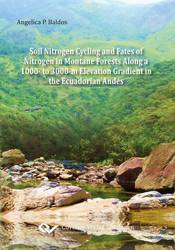| Fachbereiche | |
|---|---|
| Buchreihen (96) |
1378
|
| Nachhaltigkeit |
3
|
| Gesundheitswesen |
1
|
| Geisteswissenschaften |
2364
|
| Naturwissenschaften |
5406
|
| Mathematik | 229 |
| Informatik | 319 |
| Physik | 980 |
| Chemie | 1363 |
| Geowissenschaften | 131 |
| Humanmedizin | 243 |
| Zahn-, Mund- und Kieferheilkunde | 10 |
| Veterinärmedizin | 108 |
| Pharmazie | 147 |
| Biologie | 835 |
| Biochemie, Molekularbiologie, Gentechnologie | 121 |
| Biophysik | 25 |
| Ernährungs- und Haushaltswissenschaften | 45 |
| Land- und Agrarwissenschaften | 1004 |
| Forstwissenschaften | 201 |
| Gartenbauwissenschaft | 20 |
| Umweltforschung, Ökologie und Landespflege | 148 |
| Ingenieurwissenschaften |
1793
|
| Allgemein |
98
|
|
Leitlinien Unfallchirurgie
5. Auflage bestellen |
|
Erweiterte Suche
Soil Nitrogen Cycling and Fates of Nitrogen in Montane Forests Along a 1000- to 3000-m Elevation Gradient in the Ecuadorian Andes
Angelica Baldos (Autor)Vorschau
Inhaltsverzeichnis, PDF (68 KB)
Leseprobe, PDF (320 KB)
Tropical montane rainforests host an exceptional number of threatened species, are important water sources, and also contain large carbon pools. In addition, tropical forests are both sinks and sources of important greenhouses gases (GHGs) and is the largest natural source of a potent greenhouse gas, nitrous oxide (N2O). Threats to tropical montane forests are mostly anthropogenic in nature; added to these is the increasing atmospheric nutrient deposition which the tropics is facing today mainly from fertilizer and fossil fuel use and biomass burning. This is significant in terms of the global nitrogen (N) cycle whose critical product is a potent greenhouse gas, N2O. Also, the N cycle is always tied to the carbon © cycle and climate, making these major biogeochemical cycles more complex. The global N cycle is one of the most anthropogenically altered nutrient cycles on earth. Although the soil internal N cycle plays an important role in the regulation of N retention and loss, there is still a scarcity of information how the increasing nutrient deposition will impact the soil N cycle as well as the long-term fates of soil mineral N in tropical montane forests.
Against this background, we assessed changes in the soil N cycle and characterized the fluxes and fates of mineral N in neotropical montane forests under elevated nutrients inputs by means of a nutrient manipulation experiment (i.e. N, P, N+P, and control). Starting in 2008, a fertilization experiment was conducted in montane forests in Ecuador at 1000 m, 2000 m and 3000 m elevations. Each elevation had four replicate plots (20 m x 20 m each) of these treatments: control, N (50 kg N ha-1 year-1), P (10 kg P ha-1 year-1) and combined N+P. Two field experiments were conducted for this thesis. The first experiment aimed to assess changes in gross rates of N production (N mineralization and nitrification) and retention: microbial immobilization of ammonium (NH4+) and nitrate (NO3-) and dissimilatory NO3- reduction to NH4+ (DNRA), with low additions of N, P and their combination, and identify the factors controlling these soil N-cycling rates at each elevation and across the elevation gradient. The second experiment aimed to assess the fluxes of NH4+ and NO3- in different component pools of soil N and their short-term and long-term fates in tropical montane forest soils and determine the effects of chronic N addition on the net fluxes and fates of NH4+ and NO3-.
| ISBN-13 (Printausgabe) | 9783954046799 |
| ISBN-13 (E-Book) | 9783736946798 |
| Buchendformat | A5 |
| Sprache | Deutsch |
| Seitenanzahl | 120 |
| Umschlagkaschierung | glänzend |
| Auflage | 1. Aufl. |
| Erscheinungsort | Göttingen |
| Promotionsort | Göttingen |
| Erscheinungsdatum | 20.03.2014 |
| Allgemeine Einordnung | Dissertation |
| Fachbereiche |
Land- und Agrarwissenschaften
|








